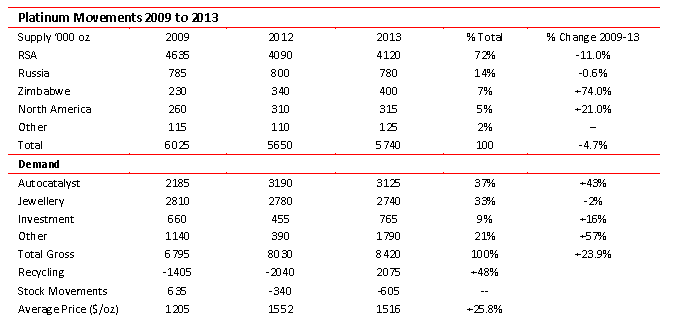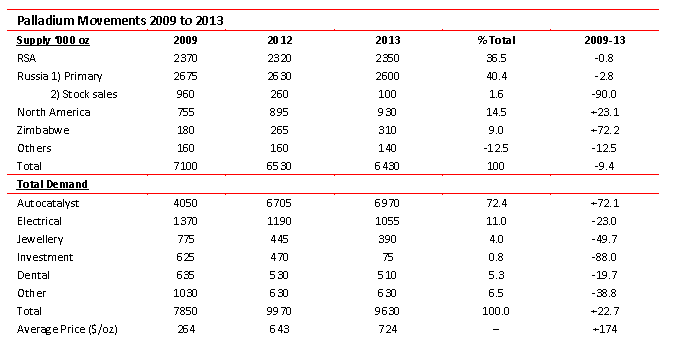Nyheter
David Hargreaves on Precious Metals, week 46 2013

The gold bulls continue to fight a rearguard action despite the price looking to have waved goodbye to $1300/oz and the looser end forecasters muttering about $1000 next stop. The Platinum premium widens and Johnson-Matthey’s 2013 interim review, just published, tells us why. It deals with all six PGMs but as Pt and Pd represent over 85% of supply we dwell on these:
Summary
Whilst the deficit is forecast to increase, supplies will rise, mostly from Zimbabwe. Gross demand will thus increase, by 4.9% to 8.42Moz. South African supplies will at best be level with 2012 as a result of industrial disruption. Autocatalyst demand will fall (2% to 3.13Moz) because of weakness in the two largest diesel markets, Europe and India. Industrial demand, much in the chemical catalyst sector, will rise a hefty 1.5% to 1.79Moz. Demand from jewellery will slip 1.4% to 2.74Moz. That from jewellery will slip 1.4% to 2.74Moz. Recycling from spent autocatalysts will rise 12.8% to 1.28Moz.
The ETF sector has been a success, largely thanks to the offtake in RSA of a record 765,000 oz. Palladium presents a marginally different picture. Primary supplies are forecast to decline a little to 6.43Moz in 2013 mainly due to a drop in sales from the Russian stockpile, much offset by recycling. The Chinese car market is set to boom, again being the major user of the metal in exhaust catalysts.
Sector Specifics
We have chosen to compare the years above because 2009 was when the economic collapse started, 2012 a time of pseudo recovery and 2013 perhaps one of reality. The long term demand for PGMs cannot be in doubt and we have constants and variables moreso than in most minerals. Geographically, mined supply is largely locked in three countries with two, RSA and Zimbabwe, suffering political palsy. It does leave investors some safer opportunities such as Stillwater (USA) and Eurasia Mining, not to be confused with ENRC, soon to delist. Demand is dictated by the autocatalyst industry moreso for Pt than Pd whilst investment is becoming a conundrum. As industrial metals, with precious qualities, Pt and Pd have a perversely double investment appeal. But that slice (about 850,000 oz or 25 tpa) sits accumulating as surface stocks, ready to come out on a price hike. The investor appetite for Pd is much reduced and we see its ratio to Pt widening. Also with our gold price barometer falling fast, the Pt/Au ratio looks set to widen. Finally, congratulations to J-M on an as-ever comprehensive and professional review. Sadly, it will be their last.
The gold bulls will not like this, but at $1282/oz at the close Friday 15th November, the price is down and showing no inclination to rise back above the $1300 threshold. This metal, which has few industrial outlets, relies on sentiment and fear, both of which channel it into investment mediums, usually short term. A growing one is the exchange traded fund (ETF). Now that authority, the World Gold Council or WGC, says in its Q3 2013 review that:
- Overall demand fell 21% year-on-year, via outflows from ETF positions, mostly.
- Eastern markets remained resilient (the buying balance is shifting from West to East).
- Bar and coin demand was up a bit, but investment demand took the big hit. It went like this:
Two features stand out: the rising level of consumer demand and the market shift from West to East.
Central Banks. News seekers are trying to tell us that Russia is trying to build up its corporate stocks. It added 18.7t in Q3 to total 1,015t, now breaching the 1000t mark for the first time. That makes it 7th in the world; a long way to go. The USA has 8134t and even Switzerland 1040t.
[hr]
About David Hargreaves
David Hargreaves is a mining engineer with over forty years of senior experience in the industry. After qualifying in coal mining he worked in the iron ore mines of Quebec and Northwest Ontario before diversifying into other bulk minerals including bauxite. He was Head of Research for stockbrokers James Capel in London from 1974 to 1977 and voted Mining Analyst of the year on three successive occasions.
Since forming his own metals broking and research company in 1977, he has successfully promoted and been a director of several public companies. He currently writes “The Week in Mining”, an incisive review of world mining events, for stockbrokers WH Ireland. David’s research pays particular attention to steel via the iron ore and coal supply industries. He is a Chartered Mining Engineer, Fellow of the Geological Society and the Institute of Mining, Minerals and Materials, and a Member of the Royal Institution. His textbook, “The World Index of Resources and Population” accurately predicted the exponential rise in demand for steel industry products.
Nyheter
Kinas elproduktion slog nytt rekord i augusti, vilket även kolkraft gjorde

Kinas officiella statistik för elproduktion har släppts för augusti och den visar att landet slog ett nytt rekord. Under augusti producerades 936 TWh elektricitet.
Stephen Stapczynski på Bloomberg lyfter fram att det är ungefär lika mycket som Japan producerar per år, vilket innebär är de producerar ungefär lika mycket elektricitet per invånare.
Kinas elproduktion kom i augusti från:
| Fossil energi | 67 % |
| Vattenkraft | 16 % |
| Vind och Sol | 13 % |
| Kärnkraft | 5 % |
Stapczynskis kollega Javier Blas uppmärksammar även att det totala rekordet inkluderade ett nytt rekord för kolkraft. Termisk energi (där nästan allting är kol) producerade 627,4 TWh under augusti. Vi rapporterade tidigare i år att Kina under första kvartalet slog ett nytt rekord i kolproduktion.
Nyheter
Det stigande guldpriset en utmaning för smyckesköpare
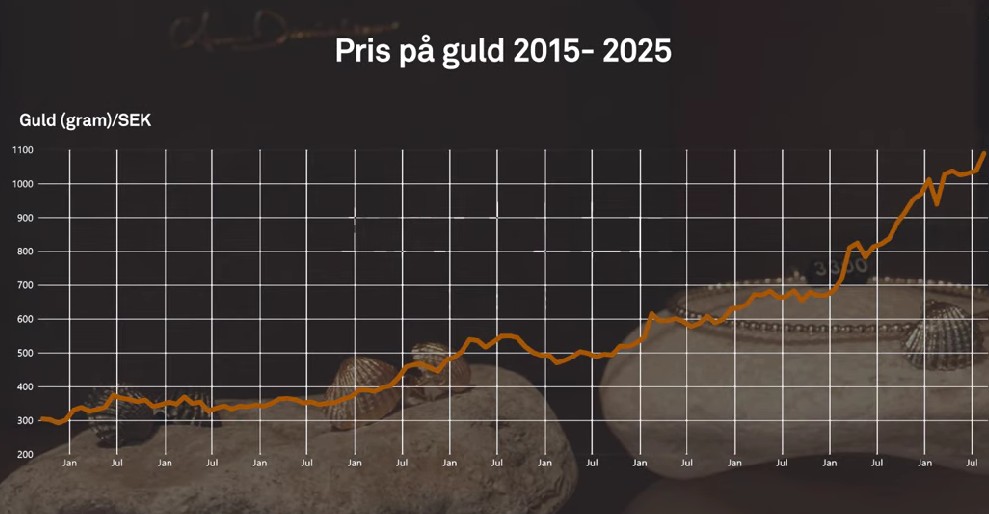
Guldpriset når hela tiden nya höjder och det märks för folk när de ska köpa smycken. Det gör att butikerna måste justera upp sina priser löpande och kunder funderar på om det går att välja något med lägre karat eller mindre diamant. Anna Danielsson, vd på Smyckevalvet, säger att det samtidigt gör att kunderna får upp ögonen för värdet av att äga guld. Det högre guldpriset har även gjort att gamla smycken som ligger hemma i folks byrålådor kan ha fått ett överraskande högt värde.
Nyheter
Aktier i guldbolag laggar priset på guld

Sedan år 2013 har aktierna i bolag som producerar guld inte alls hängt med prisutvecklingen på guld. I takt med att guldpriset har stigit så har avståndet bara blivit större. Detta trots att riskaptiten på aktiemarknaden i stort är högt.
I diagrammet jämförs priset på guld med Arca Gold Bugs Index, där indexet består av flera av de största guldbolagen.
-

 Nyheter4 veckor sedan
Nyheter4 veckor sedanMeta bygger ett AI-datacenter på 5 GW och 2,25 GW gaskraftverk
-
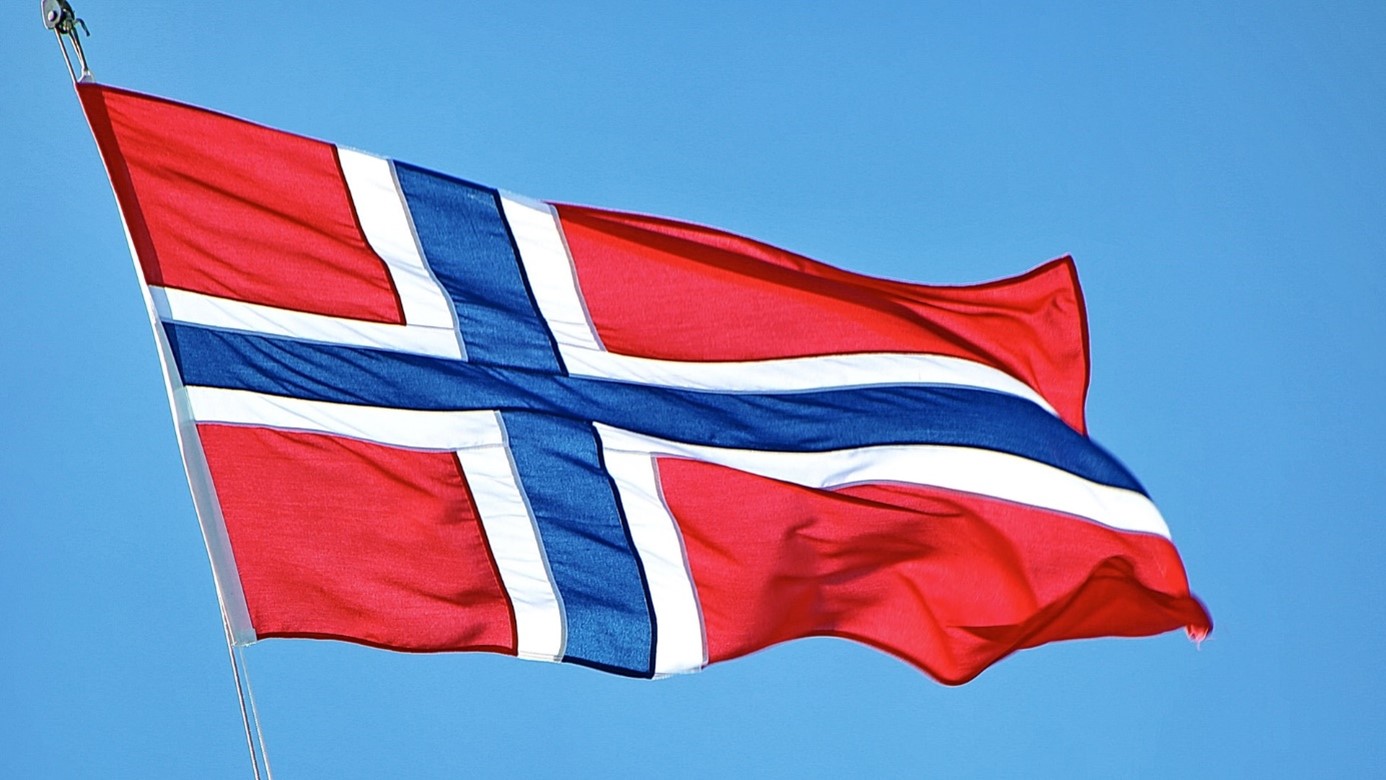
 Nyheter4 veckor sedan
Nyheter4 veckor sedanAker BP gör ett av Norges största oljefynd på ett decennium, stärker resurserna i Yggdrasilområdet
-

 Nyheter4 veckor sedan
Nyheter4 veckor sedanEtt samtal om koppar, kaffe och spannmål
-

 Analys4 veckor sedan
Analys4 veckor sedanBrent sideways on sanctions and peace talks
-

 Nyheter4 veckor sedan
Nyheter4 veckor sedanSommarens torka kan ge högre elpriser i höst
-

 Analys4 veckor sedan
Analys4 veckor sedanBrent edges higher as India–Russia oil trade draws U.S. ire and Powell takes the stage at Jackson Hole
-
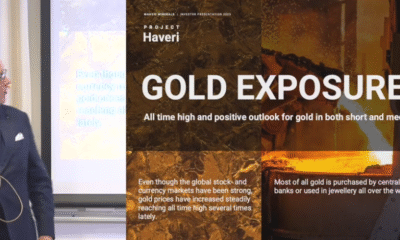
 Nyheter3 veckor sedan
Nyheter3 veckor sedanMahvie Minerals är verksamt i guldrikt område i Finland
-

 Analys3 veckor sedan
Analys3 veckor sedanIncreasing risk that OPEC+ will unwind the last 1.65 mb/d of cuts when they meet on 7 September


